Having turned 35 earlier this year, the 2022 FIFA World Cup will most likely be Lionel Messi’s last attempt at getting his hands on the biggest trophy in football. The PSG star is widely considered one of the best players of all time, if not the best. However, for most of his career, Messi has had nothing to show internationally. Although he led Argentina to the World Cup final in 2014, with Messi, the Albiceleste never looked like a real force on the global stage. That is, however, until the arrival of Lionel Scaloni.
The 44-year-old manager took over the national team on an interim basis after a rather disappointing 2018 World Cup performance under Jorge Sampaoli. Not much was expected from the former Lazio player, especially as he arrived with zero managerial experience. At any rate, after a promising start, the Argentine Football Association decided to give Scaloni a chance at the 2019 Copa América. Despite losing to Brazil in the semi-final, AFA felt as if Scaloni was building something special and allowed him to continue his job for the remainder of the World Cup cycle.
Since that defeat to Brazil on the 3rd of July 2019, Argentina have not lost a single match. With a balance between experienced players and the new extremely promising Argentinian generation, Scaloni has restored a sense of identity and pride to the Albiceleste. After leading Argentina to their first major trophy in 28 years, Lionel Scaloni and Lionel Messi have their sights on a historic world title.
This scout report in the form of a tactical analysis will provide a detailed insight into Argentina’s tactics under Lionel Scaloni. More specifically, this analysis aims to identify why and how Argentina come into this World Cup as one of the favourites to win it all.
Predicted Starting XI
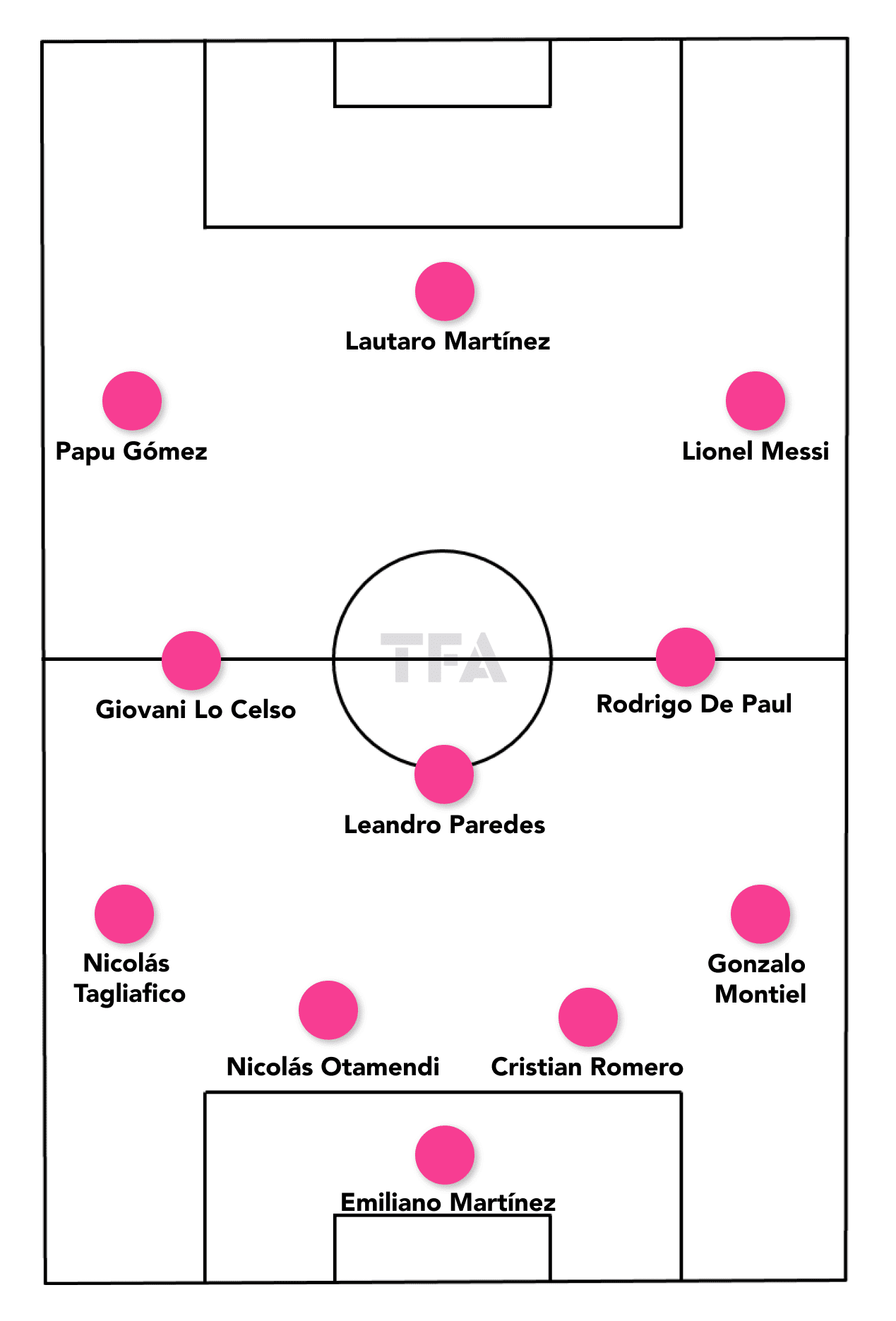
Although on paper Argentina line up in a 4-3-3, there is a defining lack of structure in Argentina’s tactics. Without adhering to a rigid shape, Scaloni’s men play a free-flowing and fluid style of football. Before examining these varying shapes and structures in the next section, it is important to understand some of the factors behind this style. The main one can be simply attributed to the players at Scaloni’s disposal.
Aside from Juventus’ Ángel Di María and Ajax’s Lucas Ocampos, there is a significant lack of true wingers in the national pool. Contrastingly, there is an overwhelming number of diverse and dynamic midfielders. As a consequence, similar to Spain’s route to glory in 2010, Scaloni’s possession-based tactics look to take full advantage of this depth in the midfield.
Looking at Argentina’s predicted starting XI, we are able to see how such a side might function. The backline is fairly straightforward, with the fullbacks having more attacking roles. In the midfield, Leandro Paredes, Rodrigo De Paul, and Giovani Lo Celso offer a balanced and dynamic trio. Additionally, ahead of them, Papu Gómez and Lionel Messi are almost false wingers, constantly drifting inside to create superiority. Lautaro Martínez is the marksman up front, but he is also capable of providing support in possession.
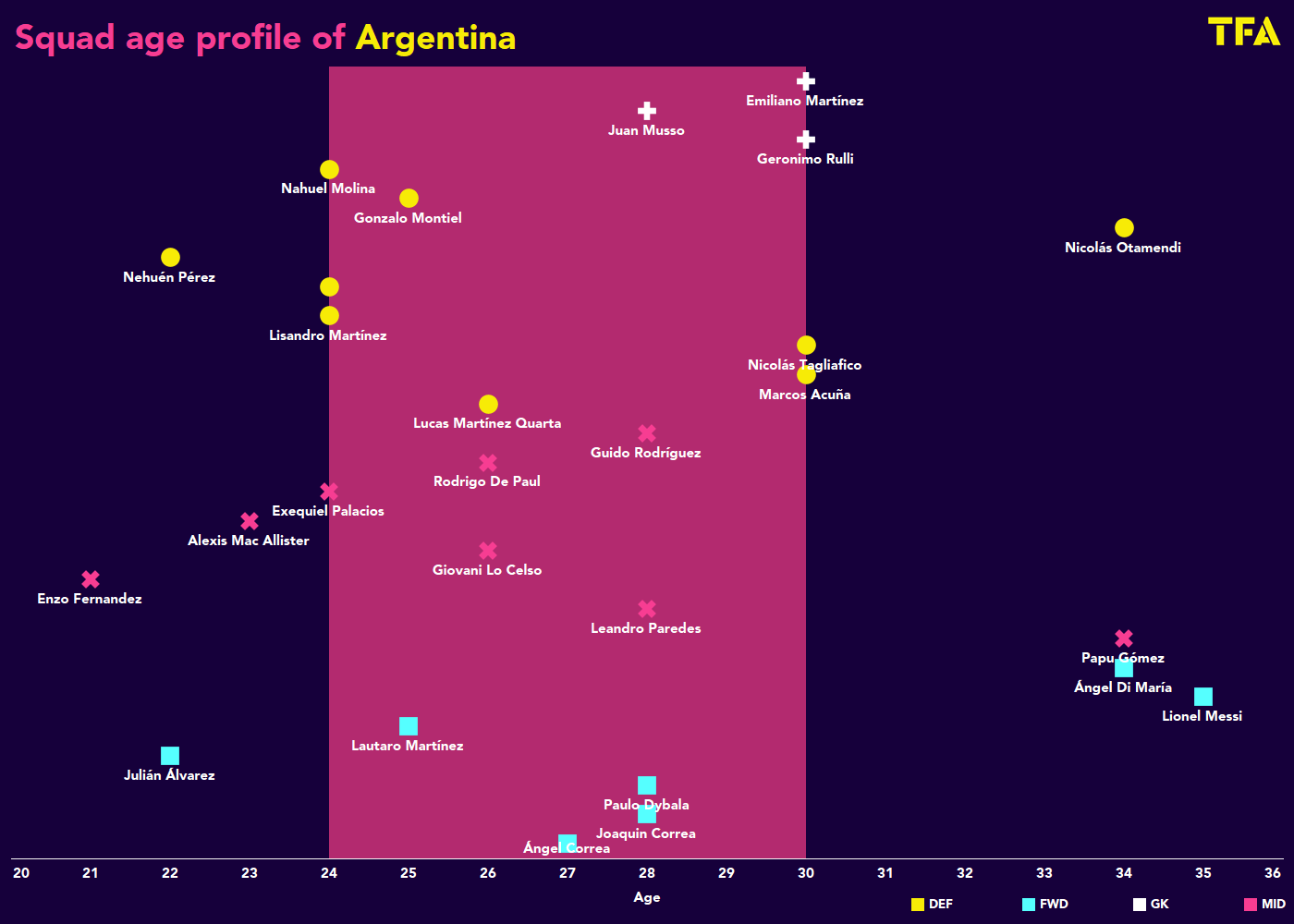
Argentina’s age profile further indicates why this World Cup might be their best shot at the title in recent decades. Quality aside, the players at Scaloni’s disposal offer an extremely desirable dynamic. La Albiceleste have tried and tested players at their disposal such as Nicolás Otamendi, Ángel Di María, and Lionel Messi.
On the other hand, they also have young and emerging stars such as Enzo Fernandez, Julián Álvarez, and Alexis Mac Allister. However, the core of Scaloni’s men are in their prime years, with the majority of players being between 24 and 30 years old.
On paper, considering age, depth, and quality, Argentina have an extremely promising squad for this year’s World Cup. What sets them apart, however, is their style. With fascinating tactics guided by a unique and historic philosophy, Lionel Scaloni has gold on his hands.
Attacking Phase
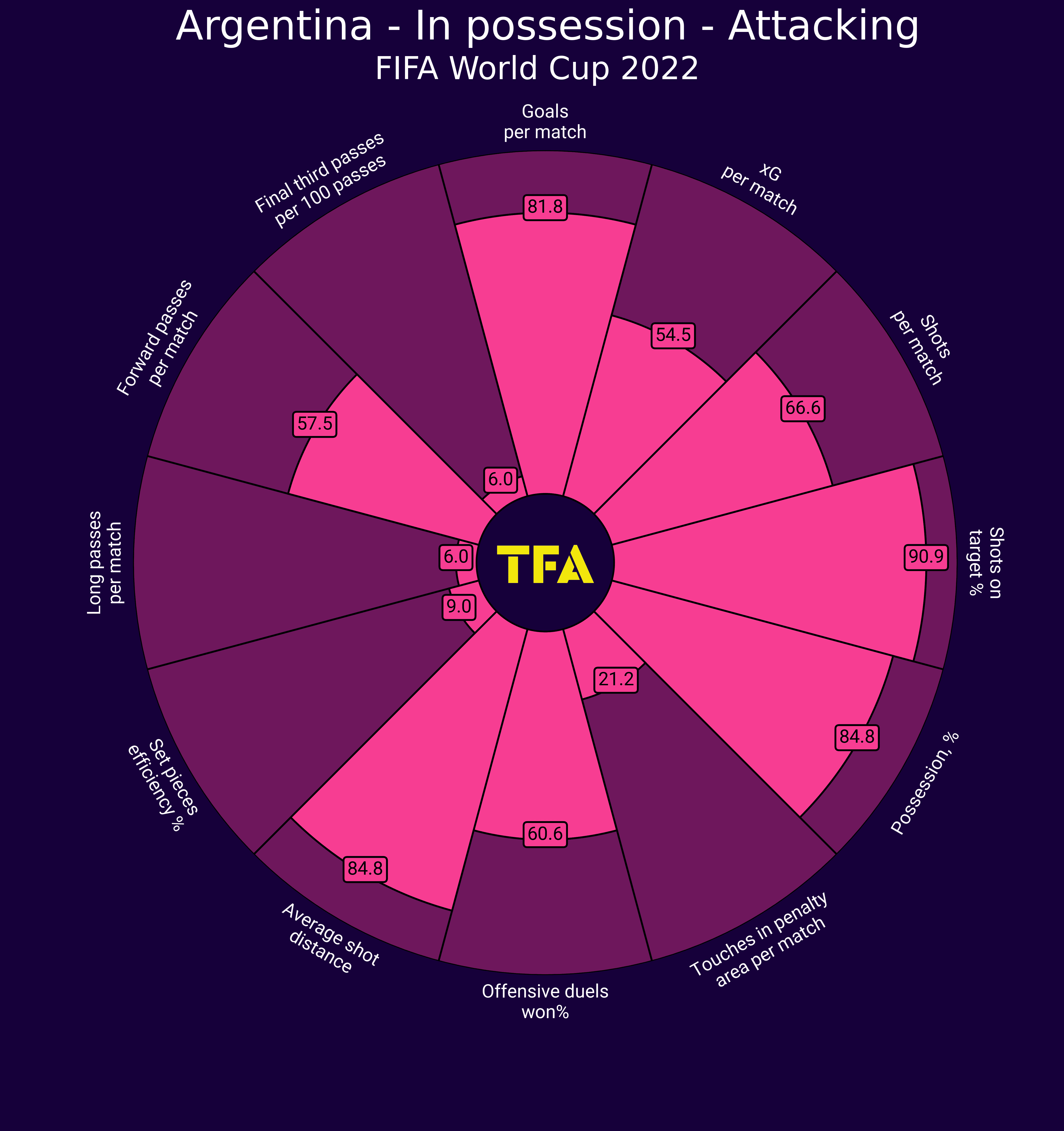
Argentina’s tactics in possession can be broken down into two sections, behavioural and structural. While these can be examined individually, they can never be thought of as separate. They work hand in hand to create a dominant and possession-based style of play, which can be further illustrated in the pie chart above. Among every team in the World Cup, Argentina rank in the 84.8th percentile for possession percentage.
This dominance is also translated into results. They are in the 81.8th percentile for goals per match, highlighting their ability to put the ball in the back of the net. Additionally, they are constantly able to create very good looks, being in the 84.8th percentile for average shot distance and 90.9th for the percentage of shots on target. Finally, another key metric that can be used to illustrate their possession style is their extremely low tendency to play it long, only ranking in the 6th percentile for long passes per match.
In possession, Scaloni’s men adopt a patient and dominant style, where they look to control the match by having most of the ball. With incisive verticality, they effectively progress through the pitch to create clear and dangerous chances. While there are many ways to go about this, structurally, Argentina do so in a very unique manner.
As mentioned, there is an abundance of central players in Albiceleste’s starting XI, let alone in the squad. Scaloni looks to take advantage of this by implementing a fluid system reliant on constant approximation and numerical superiority. Consequently, there is no set structure or shape they look to maintain. The backline is perhaps the most constant unit, but ahead of them, the players are as fluid and mobile as possible. Their structure in the build-up, as seen below, begins with a line of four behind an overloaded midfield.
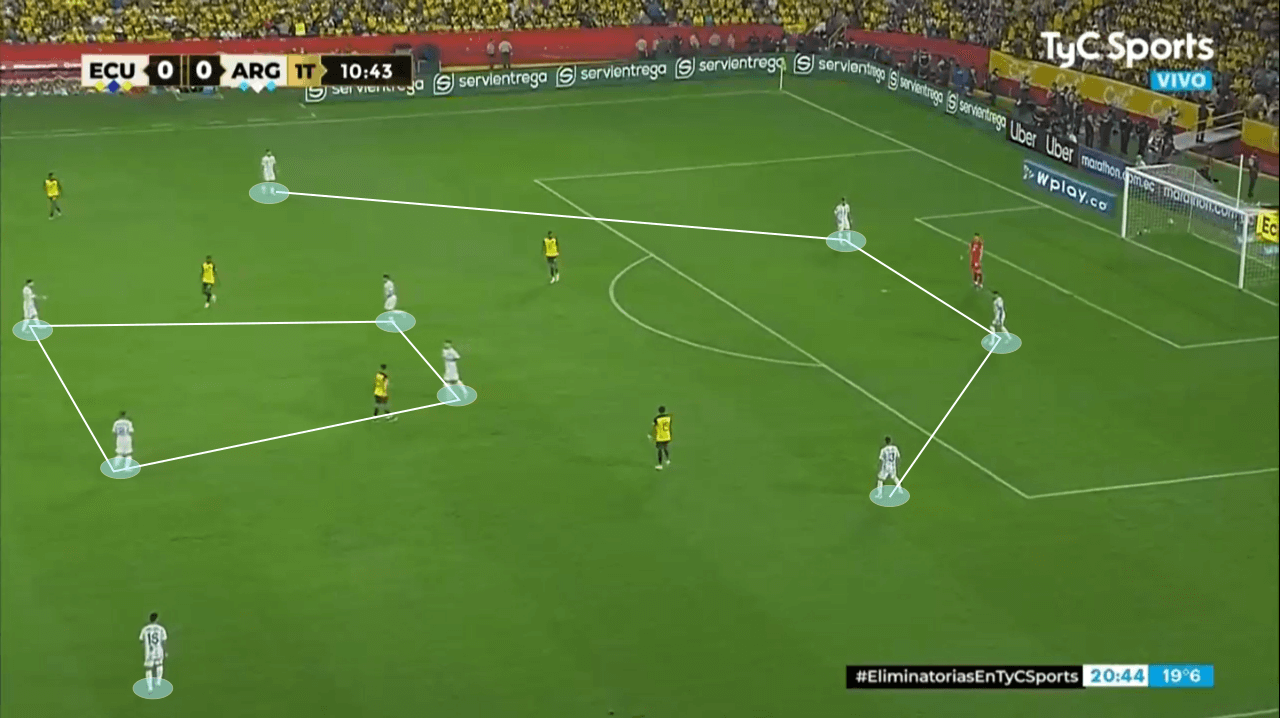
Scaloni’s men are constantly looking to create numerical superiority around the ball. In order to do so, the players are constantly supporting possession and creating passing lanes around the ball carrier. This can be further illustrated in the example below, against Italy. Argentina’s midfield collectively drops deep to support possession alongside the other centre-back and the right-back. By doing so, they create a unit of six players against Italy’s four.
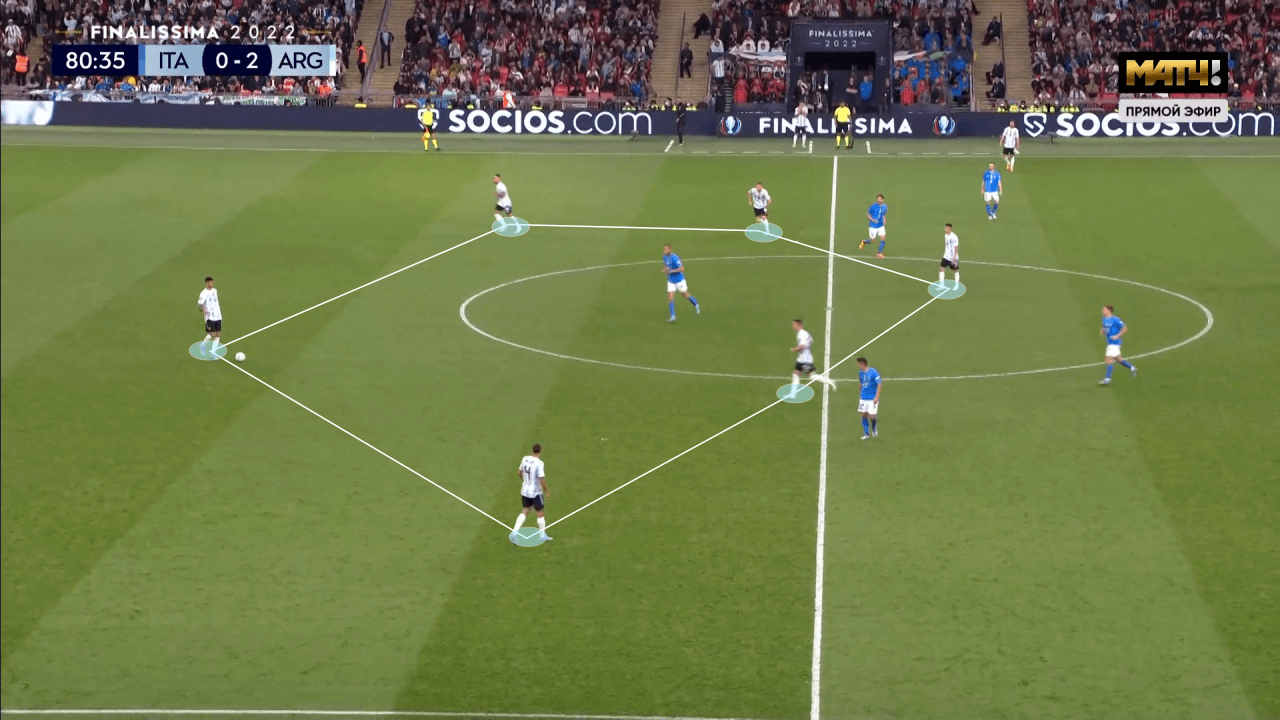
The same principle is followed in the final third. As they try to breakdown Estonia’s low block, Scaloni’s men create a 5v4 superiority on the left side. With such superiority, they are able to use their mobility, individual talent, and collective play to progress further and create dangerous chances.
Additionally, this system significantly enhances Messi’s potential. The 35-year-old thrives in tight spaces where he is able to interact with teammates to combine and progress further. While it may seem like his performances for Argentina have significantly improved lately, it is simply a result of the collective performance evolving.
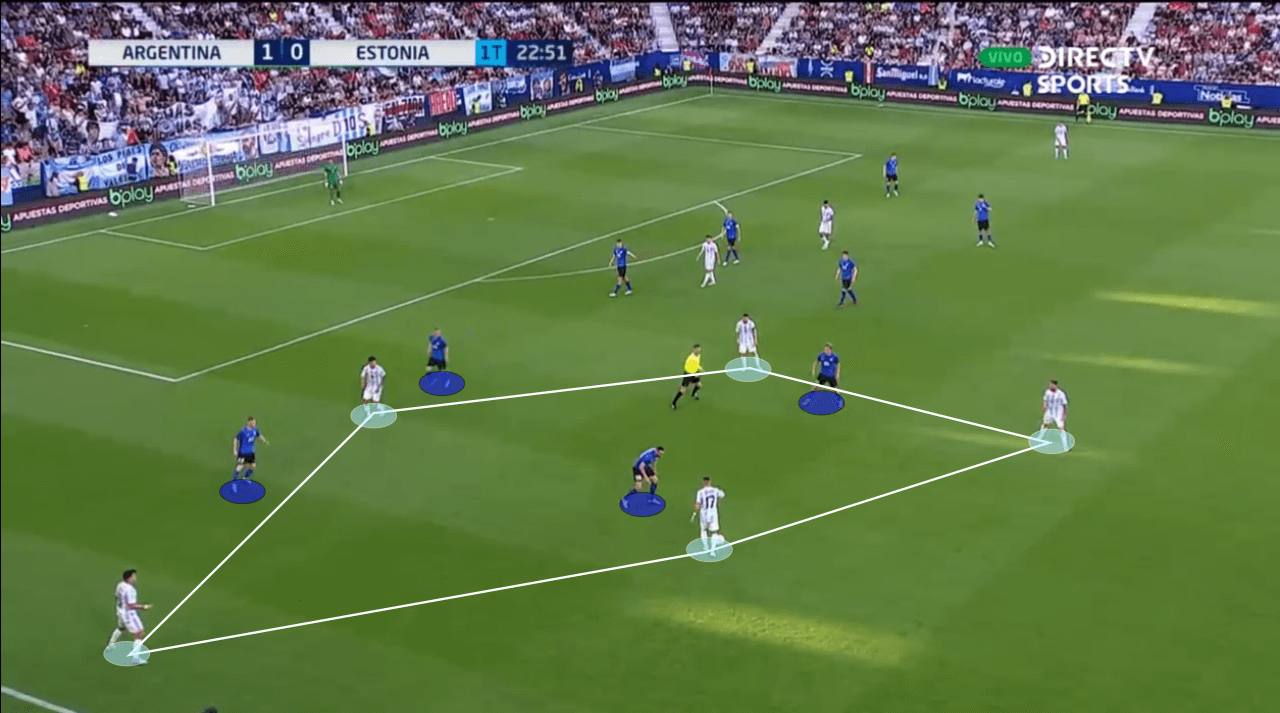
Argentina are extremely dynamic in possession, with individual talent and intuition guiding a lot of their actions. At any rate, there are certain principles, such as superiority, patience, and approximation, that dictate their collective behaviour, positioning, and mentality.
Defensive Phase
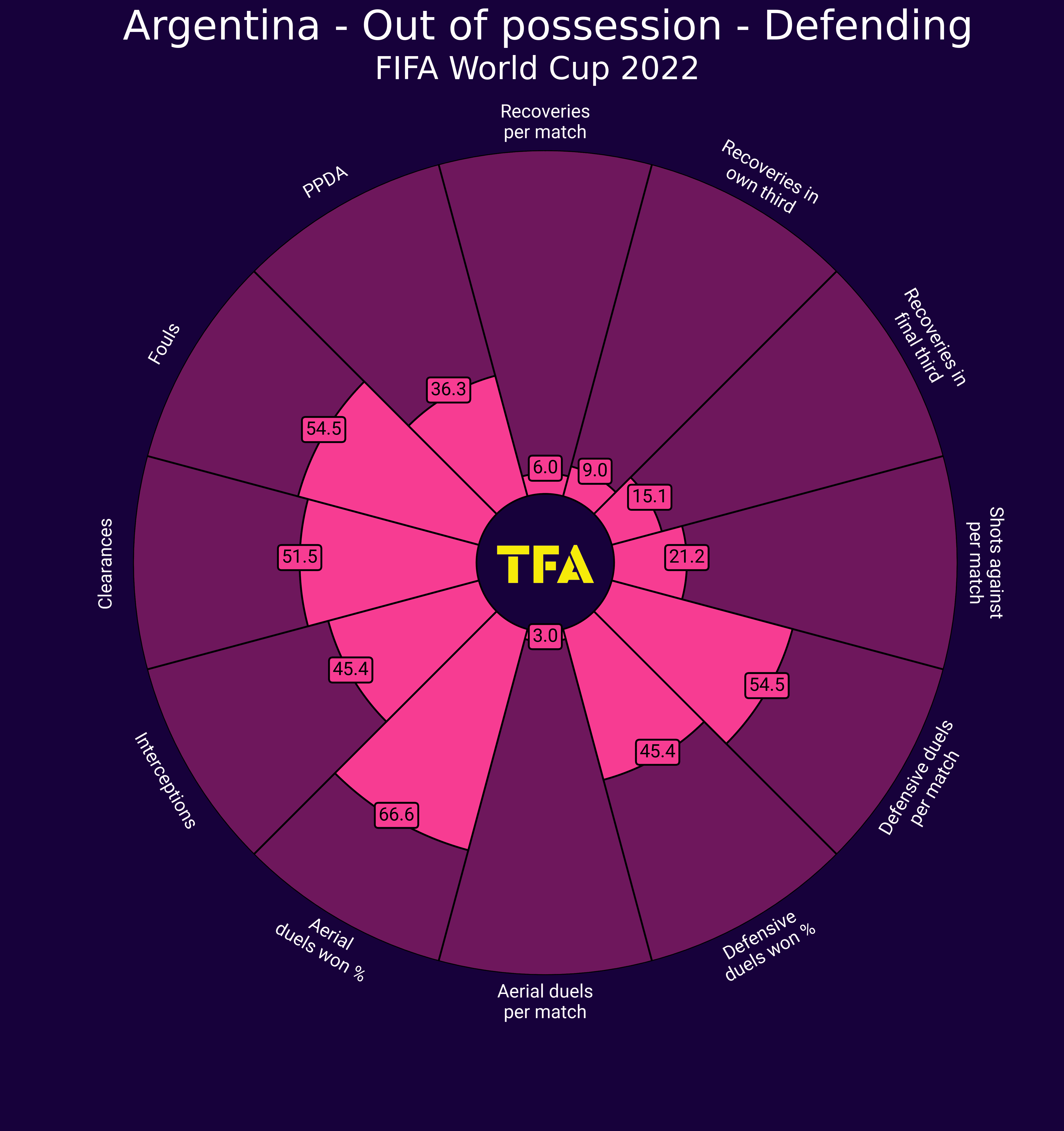
Defensively, Argentina rank incredibly low in nearly every key metric. As most defensive metrics go, volume does not indicate success. In 2022, according to Wyscout, Argentina averaged 59.21% of possession per 90. Being with the ball nearly twice as much as the opposition, it is only logical their defensive numbers would rank quite low in volume. Nonetheless, in metrics that measure effectiveness, such as the percentage of aerial duels won and the percentage of defensive duels won, they do rank quite well.
Overall, as they tend to dominate the majority of their matches, Argentina are not defending much. At any rate, they still enjoy significant defensive success. In 2022, they only conceded 0.25 goals per 90, that is only one goal every four matches. Their defensive work begins with an intense high press, as seen by their ranking in the 36.3rd percentile for PPDA.
Similar to their tactics in possession, there is no rigid structure without the ball, especially as they function in an extremely man-oriented defensive system. At any rate, the general and loose formation out of possession is a 4-4-2, with Messi joining Lautaro up top. When they press high, they do so in a very aggressive manner, often looking to match the opposition’s numbers. In the example below, against Brazil, they are able to man-mark every Brazilian player as they focus their build-up on the right side.
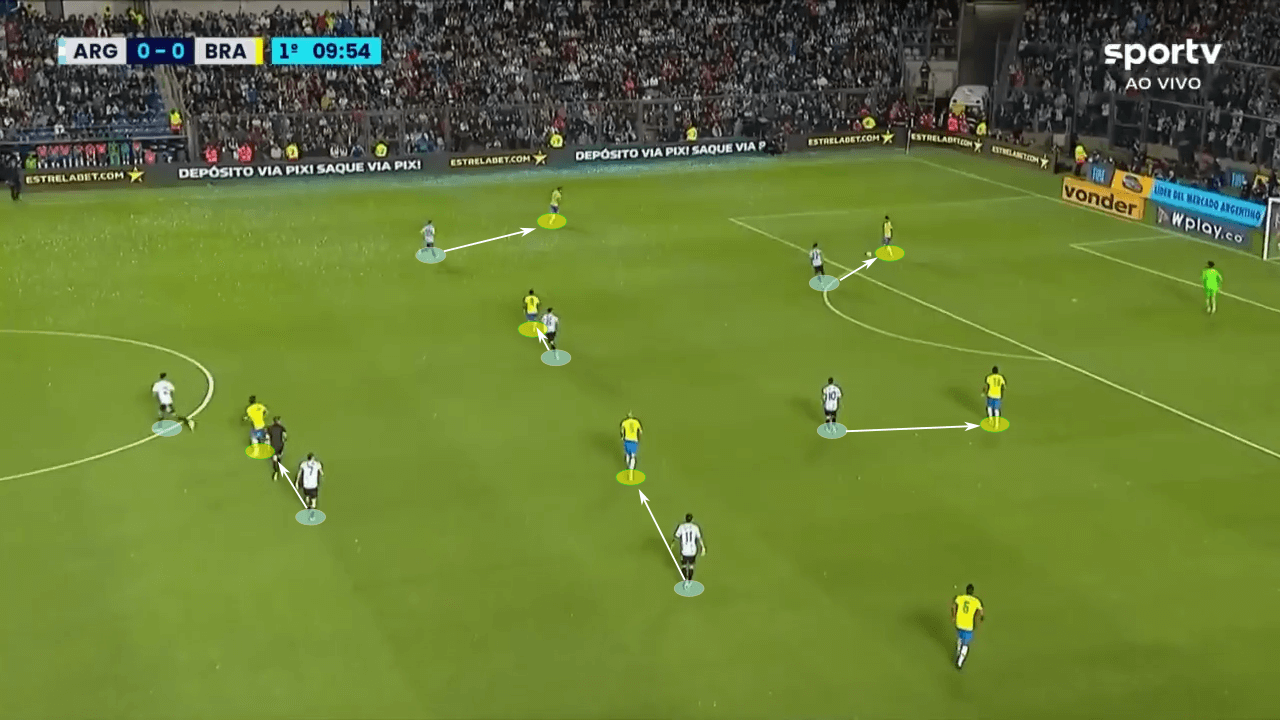
They are also extremely compact when going about their pressing. After forcing and limiting the opposition to one side, they look to squeeze them in and overwhelm them into giving the ball away. In the example below, Peru are nowhere near as structured and organised as Brazil were in the last image. Nonetheless, Argentina advance their high block and create significant numerical superiority around the ball.
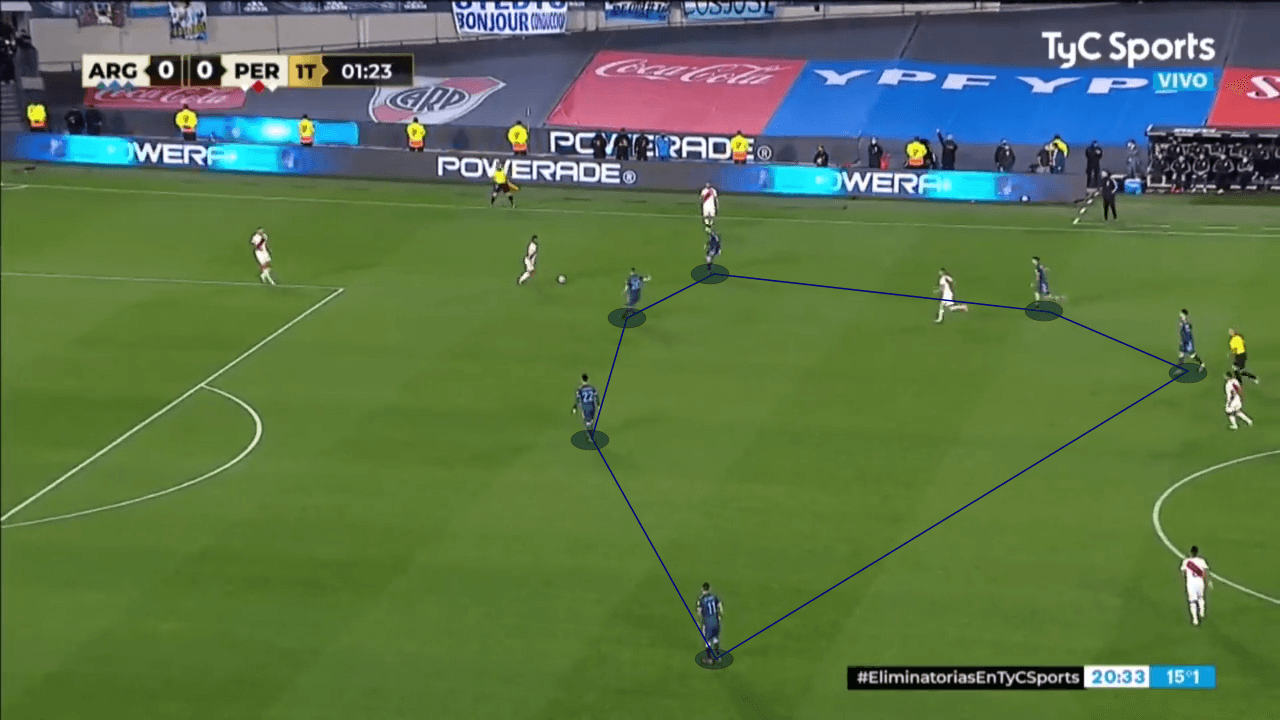
In lower blocks, Scaloni’s men revert into a more compact 4-4-2 block, with Lionel Messi being an outlet without many defensive duties. Despite generally attempting to maintain two compact lines of four, they still adhere to a man-oriented marking system. Against Italy, although a loose 4-4-2 can be identified, it is dictated by man references.
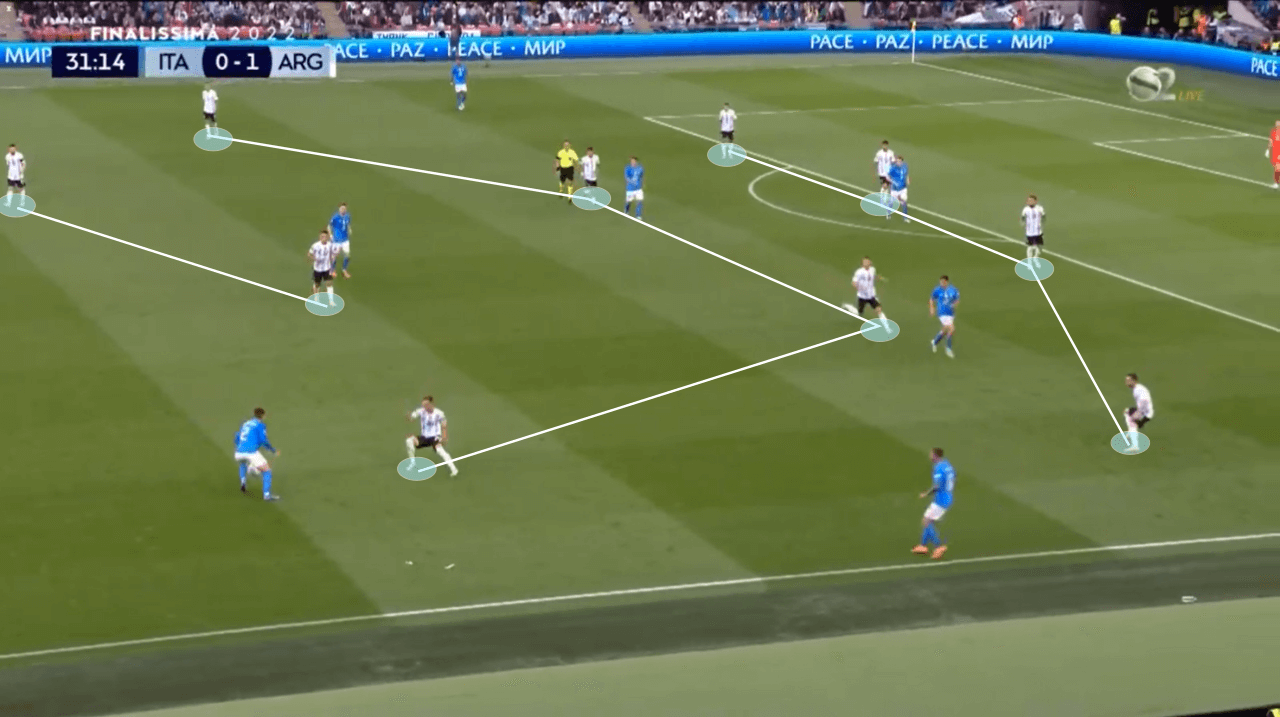
Transitions
In transition phases, Scaloni’s tactics adhere to common and modern strategies. With such talented players, when the ball is recovered, they look to immediately launch vertical counterattacks aiming to exploit the chaos that are transitions. Albiceleste’s work in the offensive transition can be broken down into two principles. The first is numbers. When launching counterattacks, Argentina look to commit a significant number of players forward in order to maximise the possible damage. In the example below, Argentina launch six players against Chile’s four.
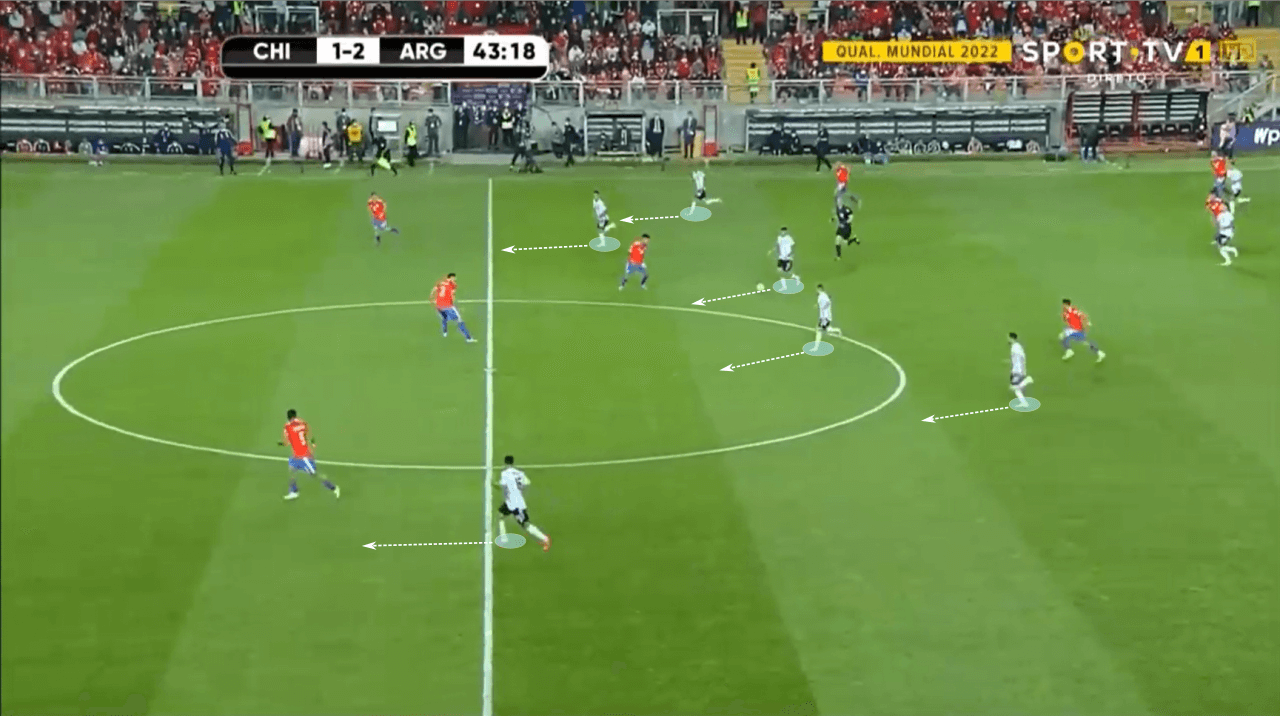
The other principle relates to coordinated movements and combinations. The beauty of transitions is how chaotic and disorganised they are. In order to take the most advantage out of this defensive disorganisation, Argentina look to perform coordinated movements and runs to manipulate the opposition and create space. Against Chile, they perform a quick combination to reach their centre-forward. Meanwhile, three other players are sprinting forward to support the counterattack.
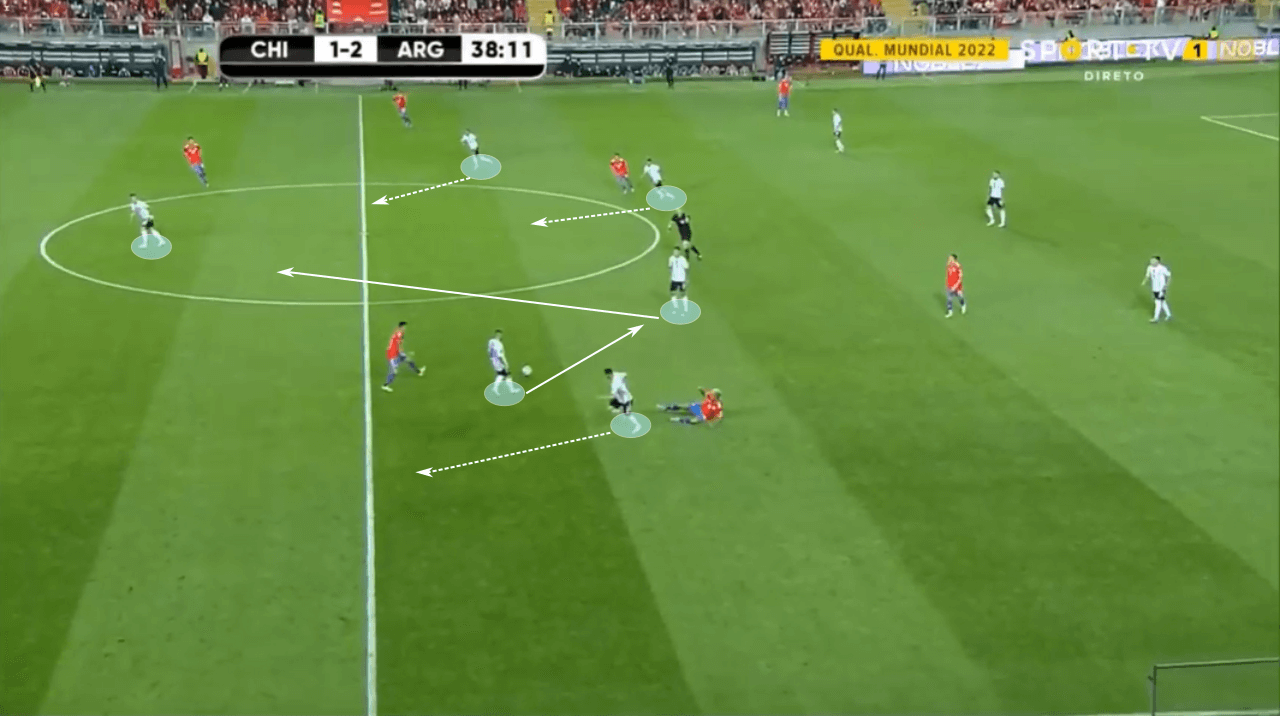
Unsurprisingly, their defensive transition begins with a counter-press. Immediately after losing possession, Scaloni’s men are instructed to instantly pressure the ball and keep the opposition from getting out. If unsuccessful, they aim to delay the play as they reorganise themselves defensively. As their possession structure involves a high number of players around the ball, when they lose it, they already have a lot of players near the ball to initiate the counter-press.
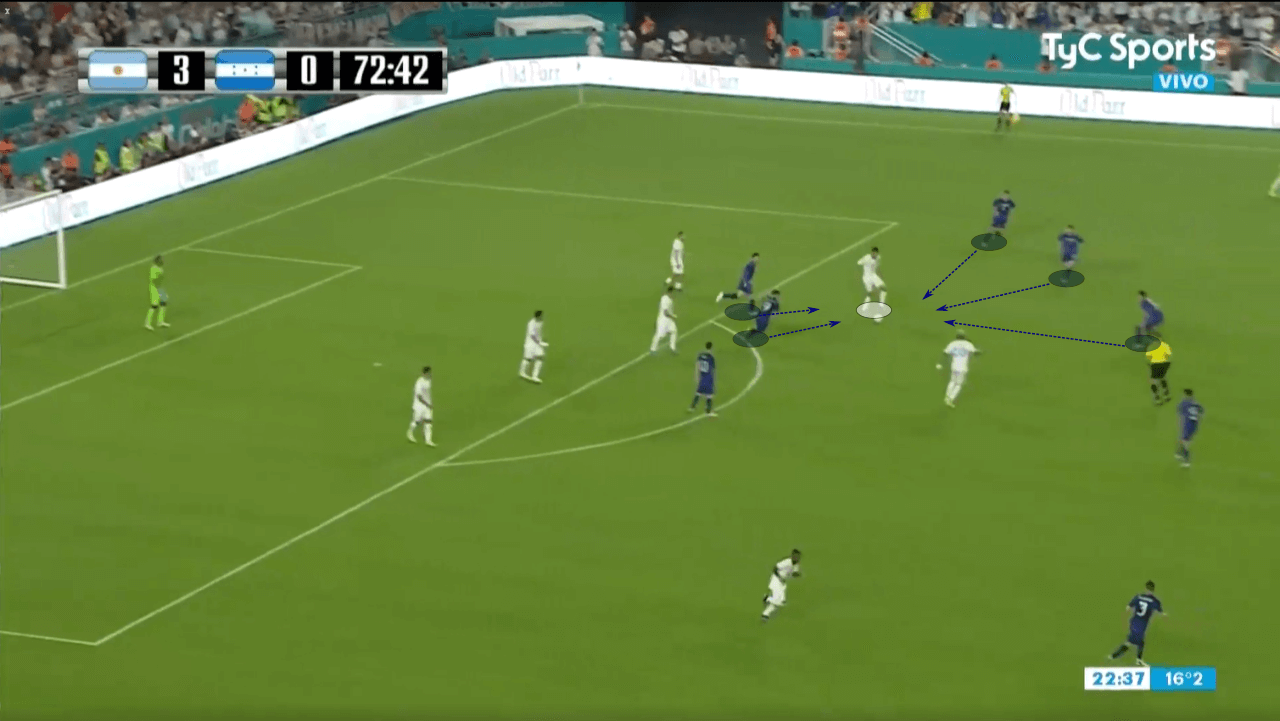
Attackers
The forwards are Argentina’s most star-studded unit. Lionel Messi leads the line, averaging an incredible 0.78 goals per 90 and 0.52 assists per 90 this season. Beside him, Lautaro Martínez, Ángel Di María, Paulo Dybala, Ángel Correa, and Julián Álvarez are all options. Di María has been struggling with injury this season but should be expected to return in time for Qatar. Dybala also suffered an injury scare recently, and the Roma star is currently racing against time to participate in the World Cup.
Lionel Messi aside, Lautaro Martínez is perhaps the biggest name on this list, and should Argentina win the World Cup, he will certainly play a big role in it. The Inter marksman averaged 0.67 goals per 90 last season and comes into this World Cup at the peak of his career. At any rate, Argentina have undeniable depth and quality in the final third, with stars who lead some of the world’s biggest clubs.
Midfielders
Scaloni’s midfield is the heart of this new-look national team. There are no star players in this section of the pitch, but on the other hand, there are numerous unsung heroes who are capable of doing the dirty work and working together to supply their dangerous forward line. Lo Celso, De Paul, and Paredes lead the midfield, with the three being perhaps the most popular players in this section of the pitch. Nonetheless, across the whole midfield section, there is a great balance in style and characteristics. Additionally, the majority of these players are between 23 and 28 years old.
Defenders
Albiceleste’s defence has a balance between more experienced players such as Nicolás Otamendi and Nicolás Tagliafico and young stars such as Cristian Romero and Lisandro Martínez. With Otamendi being perhaps the leader on the pitch, the former Man City defender brings seven World Cup appearances of experience. Additionally, Romero and Martínez are leading Tottenham and Man United’s backlines, respectively. With great depth and quality, Argentina have a very secure defence to hold down the fort when needed.
Key player
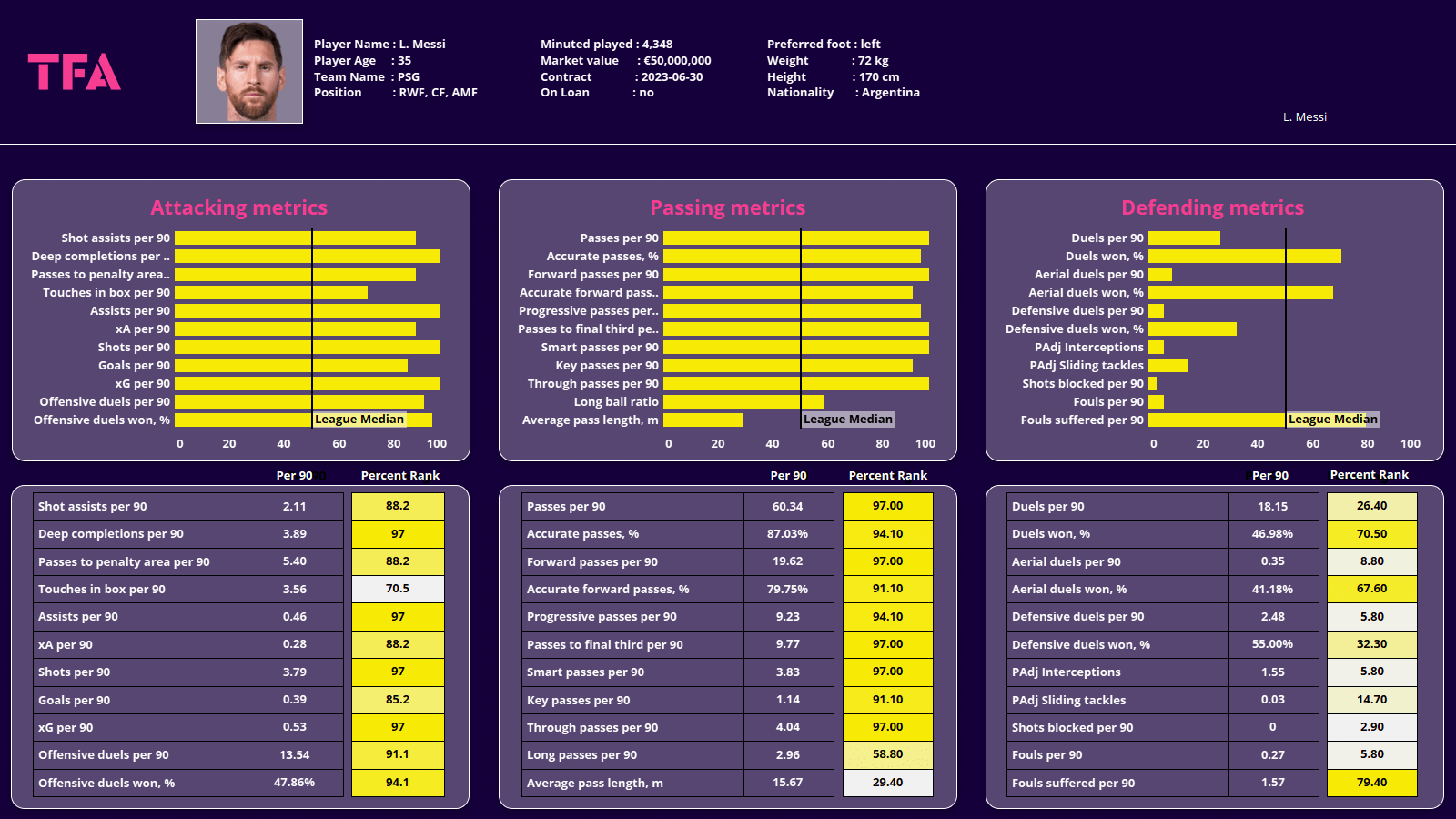
There is not much to say when referring to Argentina’s best performer. Lionel Messi is one of the best players of all time and after an illustrious career, he looks to cap it off with a World Cup title. After an underwhelming first season at PSG, the 35-year-old has bounced back this season averaging incredible numbers. In both attacking and passing metrics, Messi ranks incredibly high in all statistics. In the attacking department, his 97th percentile for both assists per 90 and xG per 90 is especially notable. Passing-wise, Messi is one of the most dangerous and effective forwards football has ever seen, ranking above the 95th percentile in nearly all metrics.
Messi’s quality is undisputed, and for the first time in his career, the Barcelona legend finally has a team performing up to his standard. With a squad willing to go the extra inch for him, he has everything he needs to secure the most important trophy in football.
Tournament Prediction
Despite not having won the competition since 1986, Argentina enter the 2022 Qatar World Cup as one of the favourites to take the trophy home. Under Lionel Scaloni, Albiceleste have not lost a single match since 2019. With the 45-year-old manager seeming to have found the perfect recipe, we will see if Lionel Messi can finish off his career with a fairytale ending.

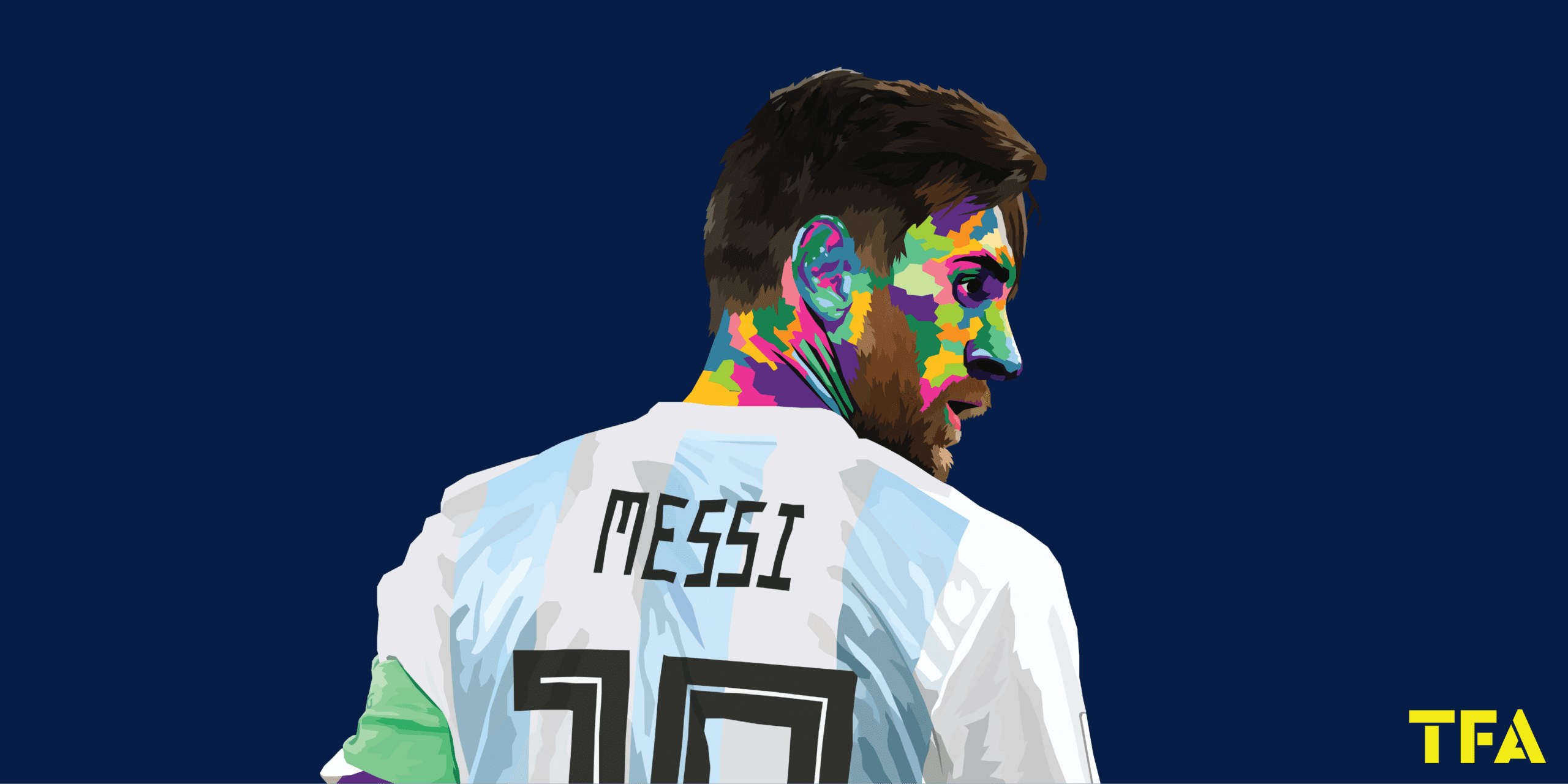



Comments